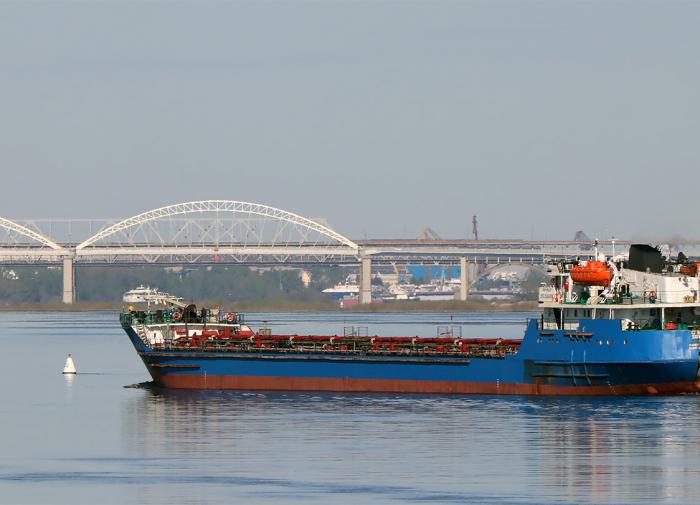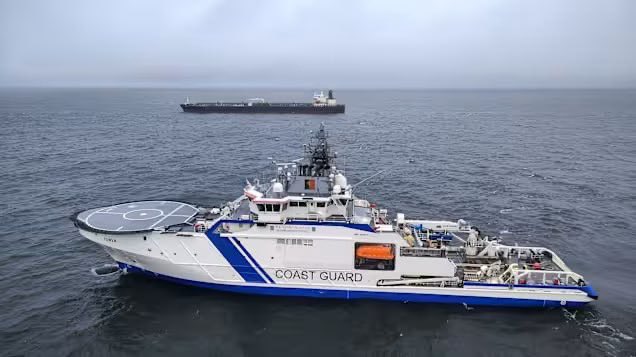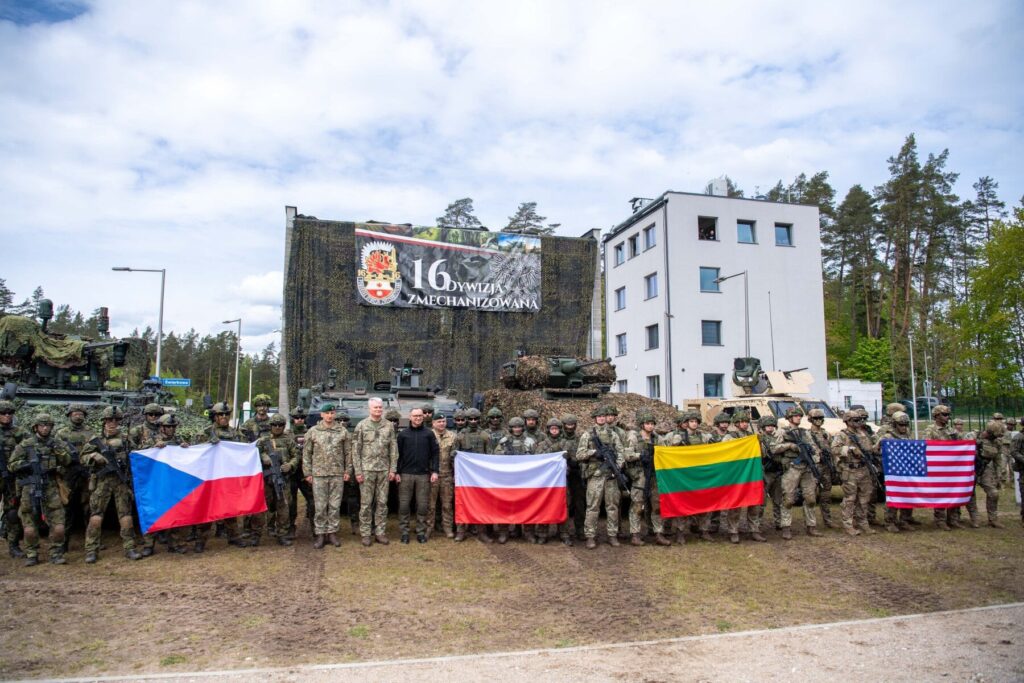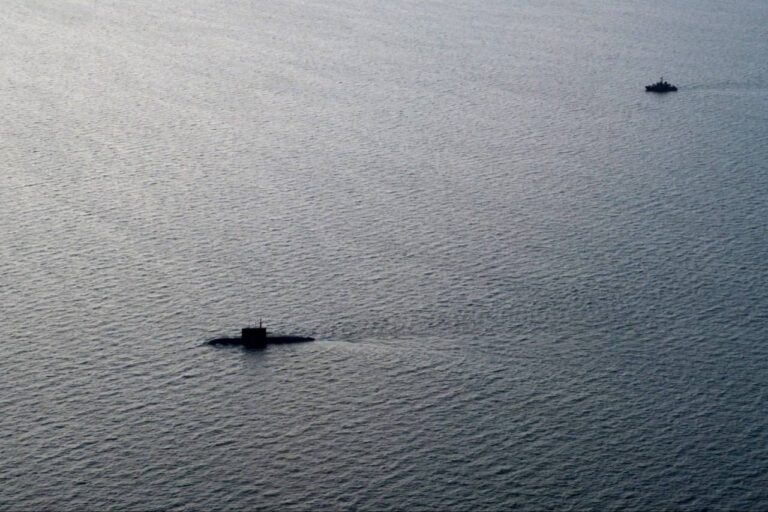At present, the Kremlin appears to be repeating its Cold War–era strategy in the Baltic region, manifested through hybrid operations and deliberate provocations aimed at drawing NATO into a conflict. The objective remains the same — to achieve political goals through psychological intimidation and coercive signaling.
Thus, we are convinced that Russia is waging a new Cold War in the region, relying on the Soviet Union’s experience and operational models.
Despite the low probability of an intentional large-scale conflict, several factors increase the risk of accidental escalation. These include the poor technical condition and wear of Russian military equipment, which can lead to mechanical failures and accidents, as well as the human factor — the low professionalism and insufficient training of Russian personnel, who are often unprepared to make independent decisions in non-standard or emergency situations.
On October 15, 2025, the Royal Swedish Navy publicly reported that it had detected and escorted a Russian submarine in the Baltic Sea.
On October 14, 2025, the Russian submarine entered the Baltic Sea through the Great Belt Strait (located between the Danish islands of Zealand and Funen, considered the main of the three Danish straits connecting the Kattegat and the Baltic Sea). Alongside Swedish Navy vessels, units of the Swedish Air Force, including fighter jets, also took part in escorting the Russian submarine. Swedish military officials stated that this was a routine operation carried out in close cooperation with Stockholm’s NATO allies.
The day before, the NATO Allied Maritime Command reported that the Russian submarine rossiysk had surfaced off the coast of France. The Dutch Ministry of Defence confirmed that the country’s navy had escorted the Novorossiysk(which was in an emergency condition due to mechanical failure.) and the tugboat Yakov Grebelsky in the North Sea — suggesting that the submarine was being towed. On October 13, 2025, NATO Secretary General Mark Rutte publicly mocked Russia’s technological and military backwardness following the breakdown of its submarine.
Swedish Prime Minister Ulf Kristersson stated that tensions in the Baltic Sea have sharply increased since Russia’s full-scale invasion of Ukraine in February 2022. According to him, Sweden is not at war, but there is no real peace either. It was the outbreak of the war against Kyiv that pushed Swedish policymakers to abandon two centuries of military neutrality and to apply for NATO membership — a process completed in 2024.
Kristersson emphasized that the entire Baltic region is facing intensified hybrid attacks from Putin’s Russia — including targeted disinformation, incidents involving damaged undersea cables, pipelines, and other maritime infrastructure. The Swedish leader noted that the Russian threat is likely to be long-term, meaning Sweden’s defense posture must be structured accordingly.
Recent developments point to growing tensions between Russia and NATO in the Baltic Sea. The BALTOPS-2025naval exercises have become a potential flashpoint: while the Alliance conducted large-scale maritime maneuvers, Moscow deployed 20 naval vessels to the same region, raising the risk of close encounters and provocations. Western military experts warn that the aggressive behavior of Russian forces could lead to escalation, even if a direct Russian attack on Baltic states remains unlikely.
Another major threat to the security of the United Europe is Russia’s active use of a “shadow fleet” — tankers carrying Russian oil that are now frequently escorted by military ships and fighter jets, a development that has caused serious concern in Denmark and other Baltic countries.
Russia’s hybrid activities in the Baltic Sea now include: violations of airspace and territorial waters; sabotage of undersea cables and maritime infrastructure; cyberattacks; and disinformation campaigns aimed at destabilizing the three post-Soviet Baltic republics. The political leadership of Lithuania, Latvia, and Estonia continues to warn NATO headquarters of potential Russian aggression and is urging the Alliance to strengthen its defenses overall, and its eastern flank in particular.
Soviet Submarine Operations Near Sweden During the Cold War
Throughout the Cold War, the Soviet Navy conducted persistent, covert submarine activity in and around Swedish territorial waters. These operations combined intelligence collection, surveillance of NATO activity, testing of Swedish defenses, and occasional provocations intended to probe political and military responses. The submarine incidents of the 1970s–1980s had outsize political effects in Stockholm: they undermined confidence in Sweden’s ability to remain a secure neutral, prompted major investments in anti-submarine warfare (ASW), and shaped Swedish defense policy for decades.
Objectives behind undersea activity
Soviet submarine operations in the Baltic and near Sweden pursued several interlocking aims:
- Intelligence and SIGINT collection. Submarines collected acoustical and electronic intelligence (hydrophone signatures, communication emissions) and mapped NATO and Swedish naval routines. Operating in shallow, confined waters allowed close observation of bases, shipping lanes, and exercises.
- Testing defenses and rules of engagement. Repeated incursions probed Swedish detection capabilities, response doctrines, and political thresholds for escalation. The Soviets learned where surveillance gaps existed and how Swedish forces reacted under ambiguity.
- Tactical positioning and surveillance of NATO activity. The Baltic Sea is a strategic choke-point for Soviet and NATO navies. Submarines monitored NATO movements, exercise patterns, and logistic hubs—information valuable for wartime operations planning.
- Covert operations and sabotage capabilities. There is documented concern (and in some cases evidence) that submarines or associated units prepared for or conducted clandestine insertions—e.g., depositing divers, laying sensors, or identifying infrastructure like undersea cables, pipelines and port installations.
- Political signaling and influence operations. Incidents also served a psychological purpose: undermining confidence in neutrality, raising domestic political debate, and complicating Sweden’s diplomatic stance between East and West.
Typical tactics and platforms
- Diesel-electric submarines in littoral waters. The Soviets commonly used smaller, quiet diesel boats (rather than large nuclear boats) for operations in the shallow Baltic and archipelagos because they were quieter on battery power and more maneuverable in confined waters.
- Shallow-water, near-coast skulking. Operating close to shores, among islands and fjords, where sonar performance degrades and detection is difficult.
- Night operations and snorkel transits. Moving under cover of darkness and using snorkels (diesel engines with a small mast) to extend range while minimizing acoustic signature.
- Electronic and acoustic intelligence collection. Passive hydrophone listening, recording of sonar pings, and interception of radio emissions from ships and shore stations.
- Use of deception and deniability. Where discovered, operations were often denied or dismissed by Soviet authorities, creating prolonged ambiguity and political strain.
Notable effects and incidents (illustrative, not exhaustive)
- High-profile intrusions in the 1970s–1980s led to dramatic Swedish naval responses—large hunts, depth-charging runs, and publicized deployments of ships and aircraft.
- A single grounding or capture (a high-visibility incident) could provoke national outrage and international attention; such events forced Stockholm to confront its vulnerability publicly.
- Sustained stealth presence created long-term political pressure in Sweden to bolster defense spending and reassess neutrality posture.
Broader strategic implications
- Lesson for littoral defense: Submarines are especially effective in archipelagic and shallow waters; small states with long coasts are vulnerable absent robust ASW capabilities.
- Ambiguity as a weapon: Persistent, deniable incursions leverage political and informational effects beyond their tactical value—eroding public confidence and forcing adversaries into costly responses.
- Intelligence value: Long-term acoustic and electromagnetic signatures gathered by submarines materially improved Soviet (and later Russian) maritime situational awareness.
- Precedent for modern hybrid tactics: Cold War submarine skulking foreshadows contemporary uses of covert maritime pressure, clandestine sensor deployment, and targeting of undersea infrastructure.
Takeaway
Soviet submarine operations near Sweden were a calculated combination of tactical intelligence-gathering and strategic pressure. They forced Sweden to invest heavily in ASW and to rethink aspects of its neutrality; they demonstrated how persistent, low-visibility military activity can create outsized political and security effects. For modern analysts, the Cold War pattern underscores the continuing vulnerability of littoral states to covert undersea operations and the need for layered detection, allied coordination, and protective measures for maritime infrastructure.
Key Motivations Behind Russian Undersea Operations in the Baltic & Near Sweden
- Sea-denial / Anti-access (A2/AD) pressure
- Russia seeks to restrict or complicate NATO and EU naval freedom of movement in the the Baltic Sea region by threatening submarine operations, deploying anti-ship missiles, mines, and undersea sensors
- Submarines are a key instrument for denying maritime access in crises: they can threaten shipping lanes, naval reinforcements, and logistic corridors.
- Surveillance, intelligence collection, and mapping undersea infrastructure
- Undersea cables, pipelines, data links, and power lines are vital infrastructure in the Baltic. Russian subs can collect acoustic, electromagnetic, and sensor data near critical nodes for future disruption or sabotage
- Recent cable disruptions (e.g. in 2024 between Baltic states) have raised suspicions that reconnaissance and alignment with such incidents are part of surveillance missions.
- Testing adversaries’ detection capabilities and rules of engagement
- Operating close to NATO / Swedish maritime zones allows Russia to assess how quickly sensors, patrols, and defense systems respond. That data is useful for planning future operations under conditions of uncertainty.
- Incursions under ambiguity provide political and military signaling — “we were here, observe your capacity (or lack thereof).”
- Hybrid warfare, coercion, and signaling
- Undersea activity serves as a component of a broader hybrid campaign — coercing, intimidating, or destabilizing without open conflict.
- It sends signals to Baltic states and NATO about risk, reinforcing Moscow’s narrative of being a regional naval power and exerting pressure short of war.
- Strategic positioning for escalation or crisis
- In a future conflict or crisis, control over undersea domains gives a strategic edge: ability to interdict submarine cables, lay mines, deploy special forces, or support covert operations.
- Maintaining forward posture with submarines close to Swedish or Baltic waters means shorter transit times and deeper tactical reach.
- Norm erosion and ambiguous coercion
- Repeated undersea operations help normalize heightened Russian naval presence, gradually eroding rules and deterrence thresholds.
- Because many submarine actions (especially in EEZs or overlapping waters) are deniable or ambiguous, Moscow preserves plausible deniability while exerting pressure.
- Support to fleet logistics and baseline security in Kaliningrad / enclave zones
- Russia’s Baltic enclave of Kaliningrad is a strategic outpost. Submarine operations support regional defense, protect sea lanes to Kaliningrad, and reinforce strategic depth for Russia’s Baltic Fleet.
- With coastal baselines and maritime claims being reinterpreted (e.g. new Russian maritime baseline decrees in the Gulf of Finland) Russia is tightening legal and operational control close to its shores.
Probability of conflict (next 12–24 months)
- Deliberate Russian conventional attack on a NATO Baltic state is 5–10%
Moscow lacks the spare, ready forces for a major offensive while the Ukraine war continues; NATO deterrence in the region is strong and now includes Finland + Sweden, complicating any Russian plan. - Serious military incident that escalates (air/sea collision, mis-ID at sea, missile/drone spillover) to limited use of force: ~10–15%.
High operational tempo, submarine shadowing, and “shadow fleet” escorts raise the risk of mishaps and brinkmanship—especially around exercises or infrastructure incidents. - Hybrid/covert attacks with kinetic risk (undersea cable/pipeline sabotage, GPS jamming, UAV/UGV intrusions, deniable maritime ops): ~50–70%.
The most likely vector: persistent pressure below Article 5 threshold, designed to intimidate, probe defenses, and shape public opinion.
Probability (3–5 years)
- Deliberate conventional attack: ~10–20%, conditional Rises if: (1) Russia stabilizes or “freezes” the Ukraine front and regenerates forces; (2) Kremlin perceives NATO resolve fracturing; (3) domestic incentives favor external escalation.
Falls if: sustained NATO force posture/munitions depth increases; allied air/missile defense and ISR integration tighten further; Russia’s fiscal and manpower constraints worsen.
Why a big Russian move is unlikely now
Deterrence math: The Baltics are no longer a narrow northern flank. With Sweden and Finland in NATO, the alliance has a near-continuous arc of bases, sensors, and air/sea access around the Baltic. Any Russian plan must assume rapid allied reinforcement, maritime interdiction in the Danish Straits, and air superiority challenges from day one.
Russia’s key weaknesses in the Baltic theater
Force generation & readiness
- Attrition from Ukraine: Losses in trained personnel, elite units (VDV, naval infantry), and modern armor reduce expeditionary punch and complex amphibious/airborne options.
- Low readiness cycles: Rotational strain, partial mobilization quality issues, and limited training hours for air/sea crews degrade complex joint ops.
Geography & access
- Kaliningrad is an exclave: vulnerable to isolation. Sea resupply can be contested; the Danish Straits are chokepoints under NATO surveillance and control.
- Shallow, cluttered Baltic: unfavorable to subs; easy for NATO to saturate with ASW sensors, maritime patrol aircraft, and mines in crisis.
- Amphibious shortfalls: Limited lift and escort capacity after losses and maintenance bottlenecks; opposed landings against NATO ISR/precision fires are high risk.
Air & air defense balance
- Air superiority deficit against a combined Nordic–Baltic air posture (Finland/Sweden add modern fighters, dispersed bases, and robust GBAD). Russian SEAD/DEAD performance has been inconsistent; stockpiles of PGMs are finite.
Logistics & industry
- Sanctions bite: Shipbuilding, advanced electronics, turbine/engine spares, and precision-component access are constrained.
- Munitions economics: Russia can mass quantity, but sustained high-end sortie rates and precision-strike volumes against defended targets are costly and hard to replenish.
C2/ISR and transparency
- Alliance sensor fusion: NATO’s integrated ISR (air, space, seabed sensing, AIS/cable monitoring) narrows surprise windows.
- Attribution risk: Undersea sabotage now draws fast, multinational forensic response—harder for Moscow to keep deniability in the medium term.
Political & strategic constraints
- Article 5 tripwire: Even a limited conventional attack risks a coalition response with escalation dominance.
- Domestic calculus: A failed Baltic gambit would be strategically catastrophic for the Kremlin; elites know it.
Most plausible conflict pathways
- Hybrid pressure campaign (baseline): More cable/pipeline tampering, GPS spoofing/jamming, UAV incursions, and “shadow fleet” escorts by warships. Aim: sow fear, raise insurance costs, test responses, split allies.
- Crisis miscalculation: Close pass or collision during BALTOPS-style drills; a warning shot or depth charge leads to reciprocal action and a brief exchange—then frantic de-escalation.
- Contained strike episode (low probability): Isolated Russian kinetic action against a specific asset (e.g., unmanned surface vessel or sensor node) in gray-zone conditions—met by NATO proportional response and rapid hotlines.
Watch-list indicators (early warning)
- Russian force regeneration in Western Military District/Northern Fleet: restored BTGs/brigades, amphibious groups exercising with integrated air cover.
- Large, repetitive EW/GPS denial events aligned with major NATO movements; unusual seabed survey patterns near cables/pipelines.
- Kaliningrad logistics activity: stockpiling fuel/munitions, surge sealift or rail movements through Belarus.
- Legal/claims signaling: new Russian maritime baselines/restrictions or “temporary danger areas” constricting Baltic lanes.
- Narrative prep: intensified information ops framing a NATO “provocation” around the Baltics.
- Near term: A deliberate Russia–NATO war in the Baltics is unlikely; hybrid coercion is highly likely.
Medium term: Risk of a serious incident or contained limited clash is non-trivial, but Russia’s structural disadvantages—geography, readiness, industry, and NATO’s expanded posture—make a sustained conventional campaign against the Baltics a high-risk bet for Moscow.


More on this story: Russian Sabotage of NATO’s Subsea Infrastructure in the Baltic Sea


More on this story: ndicators that Russians have attacked subsea facilities in Europe

More on this story: Risk of attack on Norway’s energy facilities reached high point

More on this story: Russia–Finland: Prospects of Military Conflict






